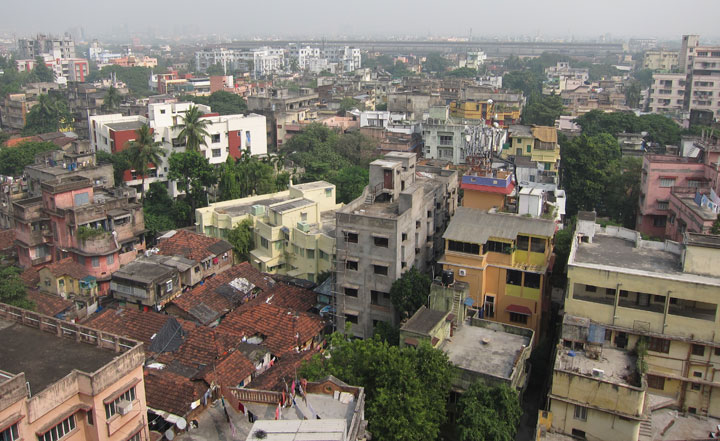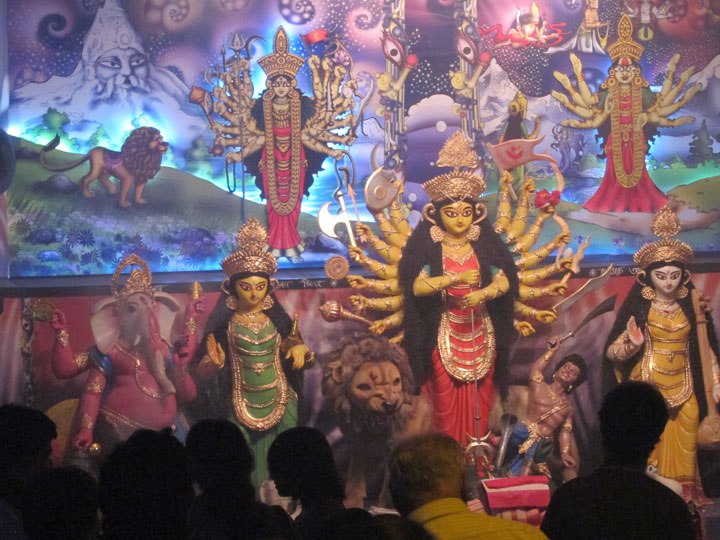
Back to SASNET South Asia travel reports October–November 2012
By Lars Eklund
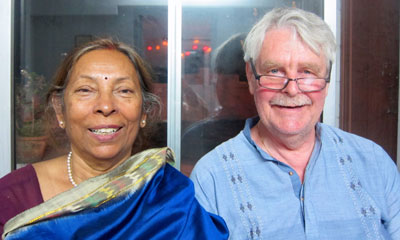 The six week period 21 October – 30 November 2012, I spent in Kolkata, India, along with my family in our flat at 23 A, Sardar Sankar Rd in the southern part of this great city, renowned for its eminence in culture and research. Excluding an eight day tour to Varanasi, Kanpur and Delhi on SASNET’s behalf, and a five day stay at Kathmandu (being partly an official SASNET visit), the rest of the time I was on spot in Kolkata. An improvised SASNET local office was therefore established, and contacts with several academics from the Kolkata universities.
The six week period 21 October – 30 November 2012, I spent in Kolkata, India, along with my family in our flat at 23 A, Sardar Sankar Rd in the southern part of this great city, renowned for its eminence in culture and research. Excluding an eight day tour to Varanasi, Kanpur and Delhi on SASNET’s behalf, and a five day stay at Kathmandu (being partly an official SASNET visit), the rest of the time I was on spot in Kolkata. An improvised SASNET local office was therefore established, and contacts with several academics from the Kolkata universities.
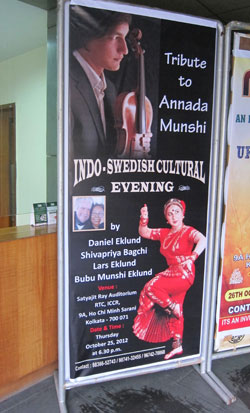 However, a major portion of the stay was solely for relaxation along with my wife Bubu Munshi (with me on photo) and our children Daniel and Marie, enjoying the festival season of Kolkata – first of all the fantastic Durga puja celebrations that this year coincided with our arrival in town – and meeting friends and relatives.
However, a major portion of the stay was solely for relaxation along with my wife Bubu Munshi (with me on photo) and our children Daniel and Marie, enjoying the festival season of Kolkata – first of all the fantastic Durga puja celebrations that this year coincided with our arrival in town – and meeting friends and relatives.
We also took part in Kolkata International Film Festival, watching Girish Kasaravalli’s prize winning new film Kurmavatara (The Tortoise), listened to Dhrupal and Baul concerts, performing ourselves singing Swedish and Bengali songs during an Indo-Swedish cultural evening at ICCR Tagore Bhavan on Ho Chi Minh Sarani, and enjoyed participating in a traditional wedding over several days when Bubu’s niece, Bharata Natyam dancer Shivapriya Bagchi(Munjini) got married.
The number of official SASNET meetings were relatively few, but are still of great importance, especially the meetings with the new Vice Chancellor of Jadavpur University, and a half day visit to Indian Institute of Management (IIM) Calcutta, India’s second highest ranked business school, and meeting Danish architect Flemming Aalund, engaged in the Serampore Project.
University of Calcutta
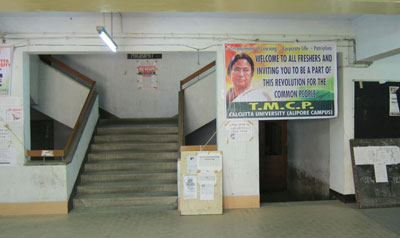 On 9th November I visited the Institute of Foreign Policy Studies at University of Calcutta (located at its Alipore Social Sciences Campus, next to the National Library and the Kolkata Zoo). In 2005, Staffan Lindberg and myself also visited the same place, see our reports, http://www.sasnet.lu.se/sasnet/contact-journey-2005calcutta-university, and http://www.sasnet.lu.se/sasnet/south-and-southeast-asian-studies-calcutta-university
On 9th November I visited the Institute of Foreign Policy Studies at University of Calcutta (located at its Alipore Social Sciences Campus, next to the National Library and the Kolkata Zoo). In 2005, Staffan Lindberg and myself also visited the same place, see our reports, http://www.sasnet.lu.se/sasnet/contact-journey-2005calcutta-university, and http://www.sasnet.lu.se/sasnet/south-and-southeast-asian-studies-calcutta-university
That time, in 2005, we concentrated on visiting the Department of History, because of its strong collaboration with Uppsala University, and the Department of South and Southeast Asian Studies where SASNET had developed personal bonds. Professor Swapna Bhattacharya, the then Head of department, was our kind host to the university, introducing us to the Vice Chancellor.
Since then, Prof. Bhattacharya has retired, and another Professor from the same department, Lipi Ghosh, has been Visiting Indian ICCR guest professor at Lund University (2010-2011). Regarding the Dept. of History, it has continued to collaborate with Uppsala, strengthened by a formal Linnaeus Palme exchange programme collaboration, and not the least because of concerted efforts by Professor Gunnel Cederlöf and her colleagues at the Dept. of History and other departments at Uppsala who are frequent visitors to Kolkata.
 My objective in visiting Calcutta University this time was more limited. I wanted to meet Dr. Shantanu Chakrabarti (on photo with Lars Eklund), Associate Professor at the Dept. of History, but also Convenor, Academic Committee, Institute of Foreign Policy Studies, one of a number of highly specialised research centres set up at the university in recent years, being funded by the University Grants Commission (UGC). It is a centre focusing on research and training programmes in foreign policy issues, with particular focus on the South Asian, East Asian, Southeast Asian and the West Asian regions. It also has a special emphasis on the international border zones of India. The programme, inaugurated in Februuary 2010 consists of policy oriented and region specific research projects along with a general M.Phil. course and short-term certificate/ diploma course for fresh and mid-career level personnel in the Ministry of External Affairs as well as other government services.
My objective in visiting Calcutta University this time was more limited. I wanted to meet Dr. Shantanu Chakrabarti (on photo with Lars Eklund), Associate Professor at the Dept. of History, but also Convenor, Academic Committee, Institute of Foreign Policy Studies, one of a number of highly specialised research centres set up at the university in recent years, being funded by the University Grants Commission (UGC). It is a centre focusing on research and training programmes in foreign policy issues, with particular focus on the South Asian, East Asian, Southeast Asian and the West Asian regions. It also has a special emphasis on the international border zones of India. The programme, inaugurated in Februuary 2010 consists of policy oriented and region specific research projects along with a general M.Phil. course and short-term certificate/ diploma course for fresh and mid-career level personnel in the Ministry of External Affairs as well as other government services.
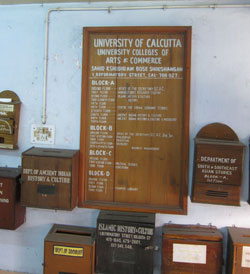 After getting through the security apparatus at the entrance to the university, being equipped with an entry slip that Dr. Chakrabarti had to sign before me leaving the campus, I went to his office at 4thfloor.
After getting through the security apparatus at the entrance to the university, being equipped with an entry slip that Dr. Chakrabarti had to sign before me leaving the campus, I went to his office at 4thfloor.
The reason for contacting Dr. Chakrabarti was that Lund University and SASNET have joined a university consortium led by Aarhus University, Denmark, in recently applying for a new European Commission funded Erasmus Mundus programme on ”Support to Indo–European Interactions on Higher Education”. The coordinator is Dr. Uwe Skoda at Aarhus. The programme aims to support institutional linkages between institutions, organize mobility of students, support research collaboration and organization of joint workshops and international conferences. It very much appears to be a follow-up programme to the EU-India Study Centres programme that ran from 2008 till 2011. More information.
University of Calcutta is another member of this consortium, and Dr. Chakrabarti the local coordinator, and that is why I wanted to discuss the prospects if the application was going to be accepted. (Unfortunately the Aarhus application was not being selected – decisions came on December 18th.)
But I also had a chance to learn about the new research centres, one of the others being a China Studies Centre, and how they work. Dr. Chakrabarti informed that they are also involved in collaboration with Warsaw University, Poland, something that has resulted in three joint conferences on International Relations.
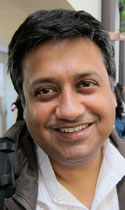
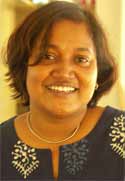
His colleagues at the Dept. of History seems to be extremely attractive for recruitment to ICCR professorships. Two of them, Professors Raj Sekhar Basu and Sanjukta Dasgupta, are currently Visiting Indian ICCR Professors in Vilnius, Lithuania, and Rome, Italy respectively. Prof. Basu has also recently asked SASNET to organise seminars for him at Lund and Copenhagen universities early in 2013.While talking about ICCR professors, it was natural that I also should meet Prof. Lipi Ghosh (photo to the right), who was the first ICCR Professor in Sweden, at Lund University during 2010-11. She is now back at Calcutta University, being Head of the Dept. of South and Southeast Asian Studies. Dr. Chakrabarti made a phone call, and Prof. Ghosh arrived after a short while. She enthusiastically informed about her recent successful tour to Myanmar, and of the major international conference that she organises in December 2012. It is the Sixth Biennial International Conference of the Indian Association for Asian and Pacific Studies (IAAPS) held in Kolkata, 17–19 December. More information about the conference.
Visit to Indian Institute of Management (IIM) Calcutta
Web page: http://iimcal.ac.in
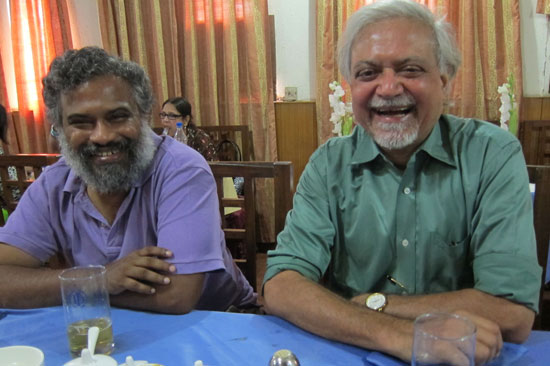
Another former Visiting Indian ICCR Professor to Scandinavia, Professor Sushil Khanna invited me to visit his premier university, IIM, established in 1974 and since about 10 years back located at its present Joka Campus on the southwestern outskirts of Kolkata. Prof. Khanna served as ICCR professor one year at Copenhagen Business School in 2010-11, and we became good friends. He participated as a main speaker in the SASNET one-day seminar on ”Managing Diversity. The Indian Experience” held in Lund on 14th April 2011, giving a lecture on “Regional and Social Diversity: The New Bourgeoisie in India”. More information.
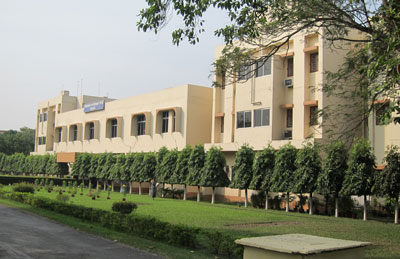 Now we met a couple of times in Kolkata on a friendship basis, and I was introduced to his IIM colleague Mritiunjoy Mohanty, Professor of Economics, as well. Jointly they persuaded me that I should include an official visit to IIM Calcutta to my itinerary, and such a visit was organised on 21st November for me to primarily meet the Dean of New Initiatives and External Relations, and Professor Ashok Banerjee, the Head of External Relations, Mr. Roddur Sen, but also other IIM faculty to learn about the university’s international contacts. It is a prestigious institution, training people to become business executives, and with many exchange students and much co-operation with Western universities.
Now we met a couple of times in Kolkata on a friendship basis, and I was introduced to his IIM colleague Mritiunjoy Mohanty, Professor of Economics, as well. Jointly they persuaded me that I should include an official visit to IIM Calcutta to my itinerary, and such a visit was organised on 21st November for me to primarily meet the Dean of New Initiatives and External Relations, and Professor Ashok Banerjee, the Head of External Relations, Mr. Roddur Sen, but also other IIM faculty to learn about the university’s international contacts. It is a prestigious institution, training people to become business executives, and with many exchange students and much co-operation with Western universities.
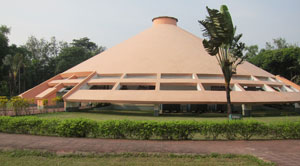 This was not my first visit to Indian Institute of Management Calcutta, ranked as the second best business school in India – with the toughest entrance admissions among all Indian IIMs. I also visited IIM on the very first SASNET contact journey in 2002. However, on that visit together with my SASNET colleague Prof. Staffan Lindberg, our visit was limited to a specific research centre within IIM, namely the Management Centre for Human Values (MCHV) – photo to the left.
This was not my first visit to Indian Institute of Management Calcutta, ranked as the second best business school in India – with the toughest entrance admissions among all Indian IIMs. I also visited IIM on the very first SASNET contact journey in 2002. However, on that visit together with my SASNET colleague Prof. Staffan Lindberg, our visit was limited to a specific research centre within IIM, namely the Management Centre for Human Values (MCHV) – photo to the left.
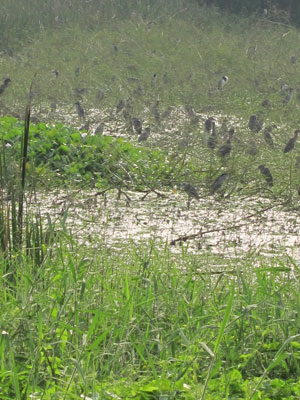 This unique centre with an aim to give ethical consideration to Indian business was established in 1992 by Professor S K Chakraborty, a man who was frequently invited to countries round the Globe, including Sweden. MCHV is funded by private and public companies, and teaches modern Indian philosophy based on the teachings of Vivekananda, Gandhi, Tagore, and Sri Aurobindo. More about our 2002 visit.
This unique centre with an aim to give ethical consideration to Indian business was established in 1992 by Professor S K Chakraborty, a man who was frequently invited to countries round the Globe, including Sweden. MCHV is funded by private and public companies, and teaches modern Indian philosophy based on the teachings of Vivekananda, Gandhi, Tagore, and Sri Aurobindo. More about our 2002 visit.
This time I spent half a day walking around the charming, peaceful and well-organised campus with its rural surroundings, and impressive buildings. A bridge designed by Pune-based American architect Christopher Charles Benninger, billed as the most innovative steel structure in India in 2010, connects the existing IIM campus to its new residential campus. It has two hostel buildings, each accommodating 175 students, with a large recreation area on the top floor. Coming up right next to the hostels is an executive centre with 200 suites. The Union Ministry of Human Resource Development is providing Rs.42 crore for the ongoing Rs.200-crore campus development project; the balance will be spent from the Rs.170-crore corpus that IIM Calcutta has built through its alumni network.
Read more in a 2011 India Today article.
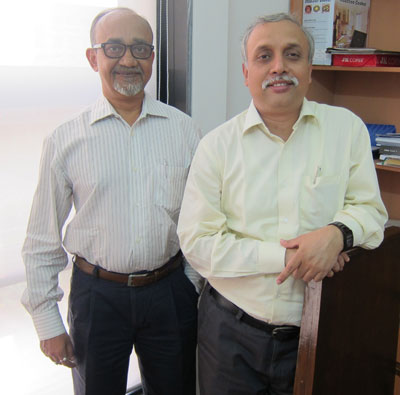
The most important meeting was however the appointment with Prof. Ashok Banerjee and Mr. Roddur Sen, who could give accurate information on number of studnents, and the high degree of international contacts. IIM Calcutta presently has about 1,000 students, out of which 900 are on Master of Business Administration (MBA) level, and 100 are PhD students. The faculty consists of 95 professors.
IIM Calcutta has MoUs on student exchange programmes with 50 foreign universities, two in Denmark (Copenhagen Business School, and Aarhus School of Business), one in Norway – Norwegian Business School in Sandvika, and one in Sweden, that is Jönköping International Business School (JIBS) at Jönköping University.
The agreement with Jönköping involves an exchange of two students every year. Other Swedish universities/business schools are welcome to negotiate on similar agreements.I returned the long way back to central Kolkata along a road encroached by construction work. A new skytrain facility is namely right now being constructed from Joka, that will end up at Writer’s Building/BBD Bag in the heart of the city. Something that will mean faster transports to reach IIM Calcutta.
Meetings at Jadavpur University
Web page: http://www.jadavpur.edu
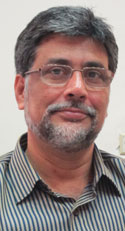 As usual when being in Kolkata, I made several visits to the prestigeous Jadavpur University, equally important university in Kolkata as University of Calcutta. Jadavpur University has been involved in the Erasmus Mundus Action 2 Asia Regional mobility programme EMEA that is being coordinated by Lund University (but unfortunately excluded in the 2013 round, see EMEA web page). The contact person at Jadavpur is Professor Mridul Bose, Department of Physics. He has become a close friend of mine, and through his kind assistance all doors are opened at the university, and two very good meetings were organised on 21st and 26th November with the new dynamic Vice Chancellor Souvik Bhattacharyya (photo to the left), and several Heads of departments.
As usual when being in Kolkata, I made several visits to the prestigeous Jadavpur University, equally important university in Kolkata as University of Calcutta. Jadavpur University has been involved in the Erasmus Mundus Action 2 Asia Regional mobility programme EMEA that is being coordinated by Lund University (but unfortunately excluded in the 2013 round, see EMEA web page). The contact person at Jadavpur is Professor Mridul Bose, Department of Physics. He has become a close friend of mine, and through his kind assistance all doors are opened at the university, and two very good meetings were organised on 21st and 26th November with the new dynamic Vice Chancellor Souvik Bhattacharyya (photo to the left), and several Heads of departments.
SASNET first visited Jadavpur University during the 2005 contact journey by Lars Eklund and Staffan Lindberg. Read their report.
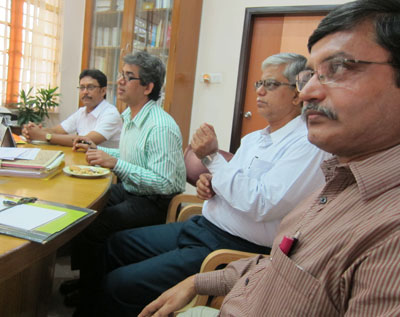 This time, focus was laid on meeting the VC, and discuss continued and extended research collaboration between Jadavpur and Lund University in fields that both universities are strong. Professor Bhattacharyya who is a Professor in Mechanical Engineering and came from Indian Institute of Technology (IIT) Kharagpur only six months before, was keen that things should be organised quickly, and after our first meeting on Wednesday 21 November when we identified areas of special competence, he quickly called for a new meeting at his office the coming Monday, to which Heads of departments were invited.
This time, focus was laid on meeting the VC, and discuss continued and extended research collaboration between Jadavpur and Lund University in fields that both universities are strong. Professor Bhattacharyya who is a Professor in Mechanical Engineering and came from Indian Institute of Technology (IIT) Kharagpur only six months before, was keen that things should be organised quickly, and after our first meeting on Wednesday 21 November when we identified areas of special competence, he quickly called for a new meeting at his office the coming Monday, to which Heads of departments were invited.
The disciplines discussed were Water Resources Engineering; Chemistry; Architecture; Electrical Engineering; Environmental Engineering; Mechanical Engineering; and Civil Engineering.A most fruitful and efiicient meeting folllowed on Monday noon, for an hour. The participants quickly presented their respective departments’ strenghts and their current foreign collaboration. The Department of Chemistry turns out to be already in close contact with Lund University through Professor Björn Lindman, Division of Physical Chemistry. He is involved in resarch collaboartion with colleagues in Kolkata. Several researchers in the chemical field have also gone to Lund as post-docs over the past 20 years or so. I know some of them very well, for example Asim and Sarbari Roy who came to Lund in the 1990s and are still working in Sweden. Also the Department of Architecture at Jadavpur have had contacts with their counterpart researchers at Lund University.
After the meeting at the Vice Chancellor’s office, the attending professors got a week to compile information about the strenght of their respective departments, and deliver to the VC. Lars Eklund would then bring the collected information back to Sweden, and present to the faculty of corresponding departments at the Faculty of Engineering, Lund University. A new way of trying to connect researchers, not being tried before. Let us see whether anything useful collaboration may come out of these efforts. See the proposals by Jadavpur University.Indo-Swedish conference on Religion & Globalization at Jadavpur University
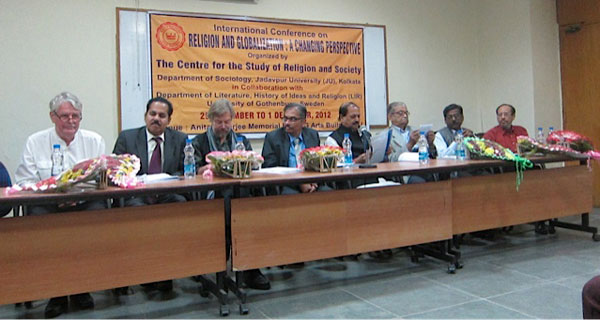 On the last day before my return flight back to Sweden, I attanded the opening ceremony and keynote speeches of the three day International Conference on “Religion & Globalization: A Changing Perspective” being held at Jadavpur University 29 November – 1 December 2012. It was being organised by the Centre for the Study of Religion and Society (CSRS), a unique endeavor of the Dept. of Sociology at Jadavpur University established in 2011 (in collaboration with Swedish researchers at the universities of Gothenburg and Uppsala), the Department of Literature, History of Ideas and Religion, Universty of Gothenburg; and the Forum for South Asian Studies, Uppsala University.
On the last day before my return flight back to Sweden, I attanded the opening ceremony and keynote speeches of the three day International Conference on “Religion & Globalization: A Changing Perspective” being held at Jadavpur University 29 November – 1 December 2012. It was being organised by the Centre for the Study of Religion and Society (CSRS), a unique endeavor of the Dept. of Sociology at Jadavpur University established in 2011 (in collaboration with Swedish researchers at the universities of Gothenburg and Uppsala), the Department of Literature, History of Ideas and Religion, Universty of Gothenburg; and the Forum for South Asian Studies, Uppsala University.

The conference convenor was Dr.Ruby Sain, CSRS chairperson.



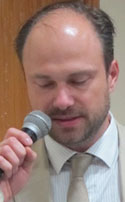
The keynote addresses were delivered by Prof. Åke Sander, University of Gothenburg, who talked about ”Religion and Society: A Global Perspective”; and by Dr. Clemens Cavallin, also from Gothenburg, who talked about ”The Concept of Religion and the Foundation of Religious Studies”.
The conference took its point of departure from the coming 150 years anniversary celebration of Swami Vivekananda’s speech at the World Parliament of Religion in Chicago in 1893. The Chicago speech became a landmark in the relations between Indic religions and the West. Vivekananda succeeded in creating a platform for interaction between India and the West that opened up the way for others to follow. His venture was based on particular philosophical, intellectual and social audience. The conference invited papers and critical reflections about this and similar processes of religious globalization within a colonial, postcolonial and postmodern context. See the full programme for the conference.
Serampore Project
 By a coincidence, I met Danish conservation architect Flemming Aalund – since 2008 engaged with the Serampore Initiative – just a few months before my 2012 South Asia tour. We met at my brother Gösta’s country house in Maglehem, Flemming being an old friend of Gösta, having met first time in Greenland 30 years ago. Flemming told me about the Serampore initiative, initiated by the National Museum of Denmark, that aims at ensuring the preservation of the physical remains of yet another Indian city that once was controlled by Denmark as a trading port – Serampore (Srirampur) located 25 km north of Kolkata along the Hoogly River. He also told me that he was supposed to come to Kolkata in the end of November along with his colleagues in the project that is going to last for the coming two to three years. So he did, and we met on a nice and sunny Sunday afternoon in the end of November, sitting on the roof terrace at my Sardar Sankar Rd flat.
By a coincidence, I met Danish conservation architect Flemming Aalund – since 2008 engaged with the Serampore Initiative – just a few months before my 2012 South Asia tour. We met at my brother Gösta’s country house in Maglehem, Flemming being an old friend of Gösta, having met first time in Greenland 30 years ago. Flemming told me about the Serampore initiative, initiated by the National Museum of Denmark, that aims at ensuring the preservation of the physical remains of yet another Indian city that once was controlled by Denmark as a trading port – Serampore (Srirampur) located 25 km north of Kolkata along the Hoogly River. He also told me that he was supposed to come to Kolkata in the end of November along with his colleagues in the project that is going to last for the coming two to three years. So he did, and we met on a nice and sunny Sunday afternoon in the end of November, sitting on the roof terrace at my Sardar Sankar Rd flat.
By another coincidence, another personal friend had also come to meet me and my family on the same day, namely Professor Subrata Chattopadhyay, Head of Dept. of Architecture, Indian Institute of Technology (IIT) Kharagpur. Subrata who has close connections to the Dept. of Architecture at Lund University since the early 1990s, and being a guest professor at the Division of Housing Development and Management (HDM) there for a full year in 2000–2001, has as a senior professor vast knowledge about conservation issues. This resulted in a fruitful discussion on the challenges and possibilities that surrounds the Serampore project. (Photo of the two)
Three weeks later I was informed by Flemming that his recent visit to Serampore along with his research partner, historian Simon Rastén, had been successful. An agreement had been signed with the district administration and the West Bengal Heritage Commission (WBHC) to start restoration work on St. Olav Church, and parts of South Gate. Times of India published an article on the issue, entitled ”Danish Team on Heritage Trail. Join Heritage Panel to loook for Frederiksnagore among Hooghly Ruins”. Read the article.
Since several years, the National Museum of Denmark has coordinated the Tranquebar Initiative, a major project to document and restore the colonial heritage of Denmark in Tranquebar (and also develop Tranquebar of today), on the Tamil Nadu coast in southern India. Tranquebar was under Danish control between 1620 and 1845. A large number of research projects have been produced, and some are still underway, on various aspects of Tranquebar (more information on the Tranquebar Inititive).
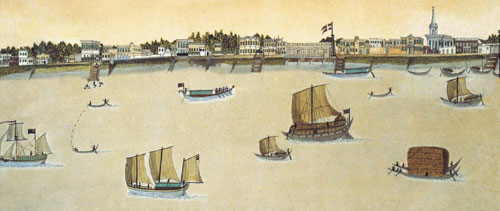 The Serampore Initiative was established in 2008 with the similar aim of identifying and describing the physical remains of the Indo-Danish history in Serampore, and by partaking in preservation collaborations, the Initiative also wishes to explore and promote knowledge of the joint cultural heritage related to Serampore.
The Serampore Initiative was established in 2008 with the similar aim of identifying and describing the physical remains of the Indo-Danish history in Serampore, and by partaking in preservation collaborations, the Initiative also wishes to explore and promote knowledge of the joint cultural heritage related to Serampore.
In 1755 the Danish Asiatic Company was granted the right to establish a trading post at Serampore (the official Danish name being Frederiksnagore). The place remained on Danish hands until 1845, when the territory was ceded to the British, together with the other Danish trading post in India, Tranquebar. Apart from its role as a commercial settlement, Serampore became an important centre of education. The Baptist mission produced and disseminated printed translations of the Bible in many Asian languages. Subsequently Serampore College, which was built under the protection of the Danish King Frederik 6, ranges among the oldest institutions in Asia with the right to confer academic degrees. Serampore College still operates today, with some of its faculties being affiliated to the University of Calcutta.
In 2010, Flemming Aalund and Simon Rastén (the two researchers who along with the ethnographer Bente Wolff make up the team behind the Serampore Initiative) published a report on Serampore’s heritage, entitled ‘Indo-Danish Heritage Buildings of Serampore‘. More information, including link to the detailed Serampore report.
Read an article on the work in progress, ”Heritage hope in Danish plan for Serampore”, published in Telegraph, 13 March 2013.
Lars Eklund